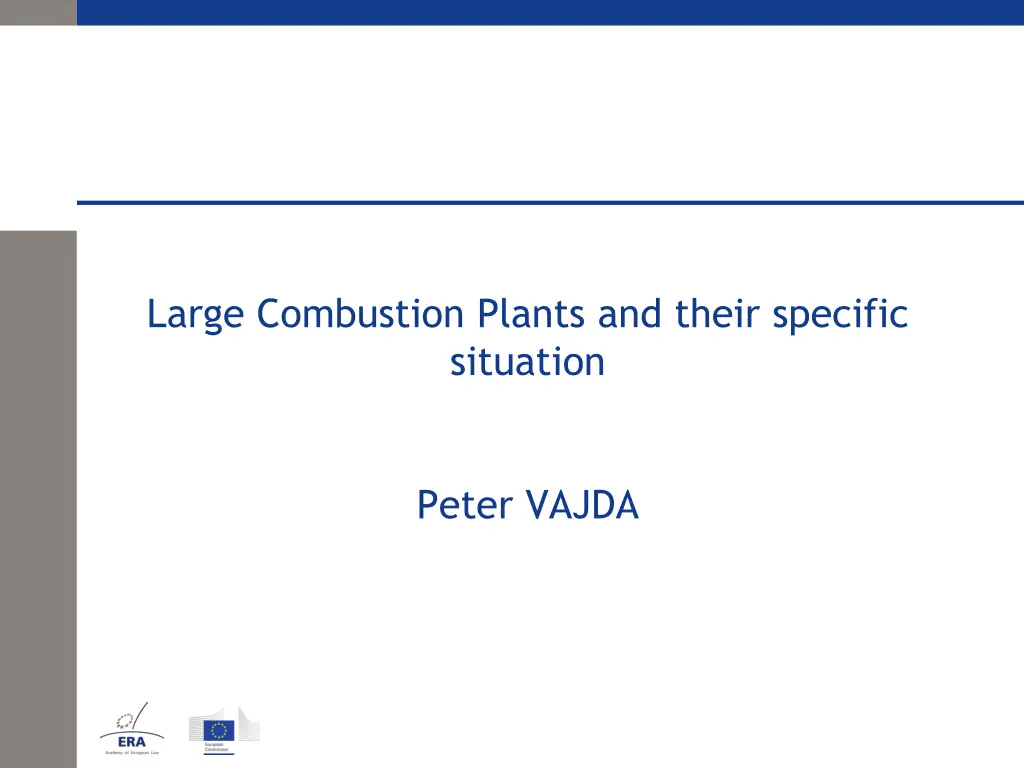
Understanding Large Combustion Plants Directive
Discover the history and main elements of the Large Combustion Plants Directive (LCPD), including emission limit values, flexibility mechanisms, and the relationship with the Industrial Emissions Directive (IED). Learn about the definition of large combustion plants, how coal-fired power plants work, and the implementation of flexibility elements. Stay informed about the regulations governing SO2, NOx, and dust emissions for plants with a rated thermal input of 50 MW. Explore the transition from LCPD to IED and the importance of compliance for a cleaner environment.
Download Presentation

Please find below an Image/Link to download the presentation.
The content on the website is provided AS IS for your information and personal use only. It may not be sold, licensed, or shared on other websites without obtaining consent from the author. If you encounter any issues during the download, it is possible that the publisher has removed the file from their server.
You are allowed to download the files provided on this website for personal or commercial use, subject to the condition that they are used lawfully. All files are the property of their respective owners.
The content on the website is provided AS IS for your information and personal use only. It may not be sold, licensed, or shared on other websites without obtaining consent from the author.
E N D
Presentation Transcript
Large Combustion Plants and their specific situation Peter VAJDA
What is a large combustion plant? LCPD definition: any technical apparatus in which fuels are oxidised in order to use the heat thus generated Fuels can be solid, liquid or gaseous coal oil natural gas Plants for the generation of heat and electricity 50 MW rated thermal input: legislative threshold How does a coal-fired power plant work?
History of the LCP Directive First European legislative instrument in this field adopted in 1988 (88/609/EEC) Current LCP Directive adopted in 2001 In force until end 2015 From 1 January 2016, IED (Chapter III and Annex V) will take over and LCPD repealed
Main elements of the LCPD Setting emission limit values for SO2, NOxand dust (particulate matter) for plants with a rated thermal input 50 MW ELVs may vary based on the RTI and the age of the plant and on the type of fuel used (see next slide) Different ELVs for new and existing plants ( old new , new new historical reasons) Provisions on monitoring Flexibility mechanisms (see later)
Emission limit values SO2, exisiting plants
Relationship between IPPC/IED and LCP IPPC/IED BAT-based permitting LCP emission limit values and associated monitoring LCP should be considered as a safety net for the application of BAT BAT LCP ELVs non-compliance
Elements of flexibility Two main ways of implementation: 1) Art. 4(1) and (2) in connection with Annexes III to VII compliance with individual ELVs 2) Art. 4(6) - preparation of a NERP Art. 4(4) - Limited lifetime derogation (opt-out) Temporary exemption for meeting the ELVs Limited in time (2008-2015) and in operational hours (20.000) Plant has to shut down at the end of the derogation period security of supply has to be strictly considered
Elements of flexibility Art. 5(1) Peak load plants If a plant only operates a limited amount of hours every year, it may be subject to less stringent ELVs Annex III, Part A Desulphurization rate (for solid fuels) Where the ELVs cannot be met due to characteristics of the fuel (coal with high S-content)
Penalties Art. 16: The Member States shall determine the penalties applicable to breaches of the national provisions adopted pursuant to this Directive. The penalties thus provided for shall be effective, proportionate and dissuasive. Alternative ways of compliance have to be considered Main reason: non-compliance with the emission limit values, inappropriate monitoring
THANK YOU FOR YOUR ATTENTION! CONTACT peter.vajda@energy-community.org
